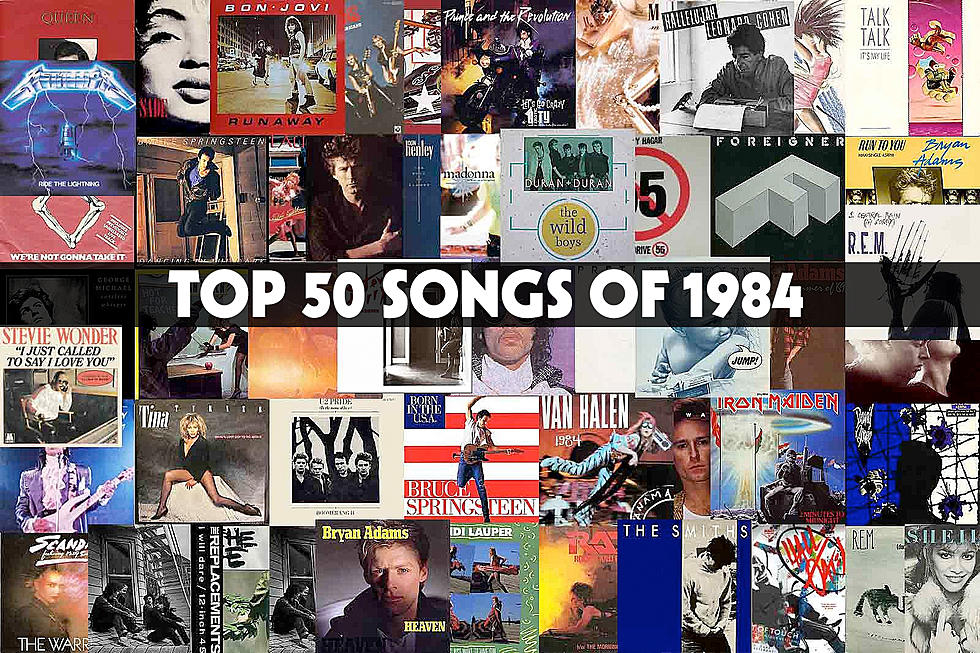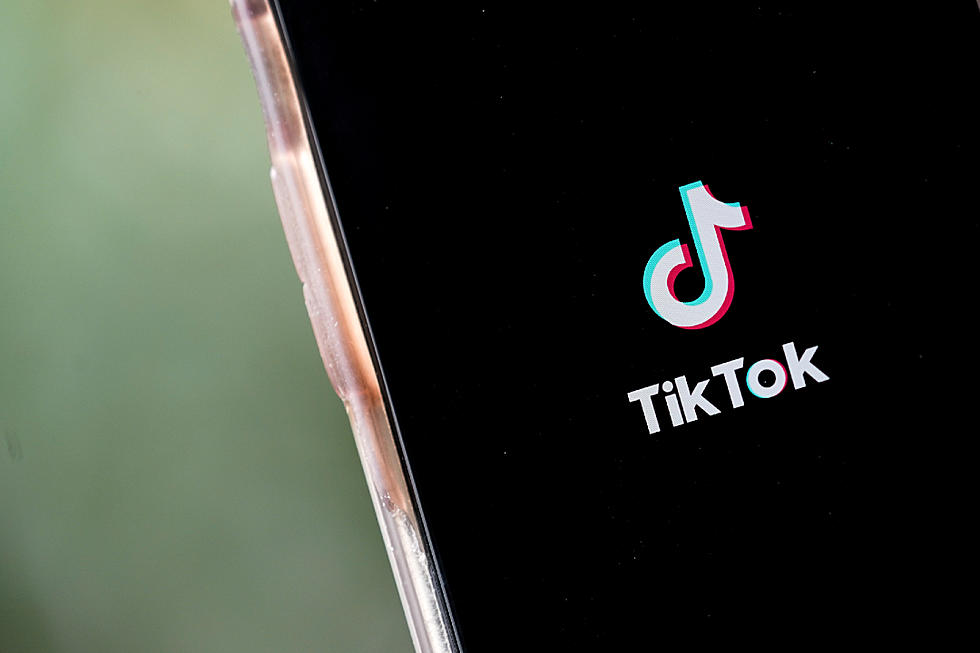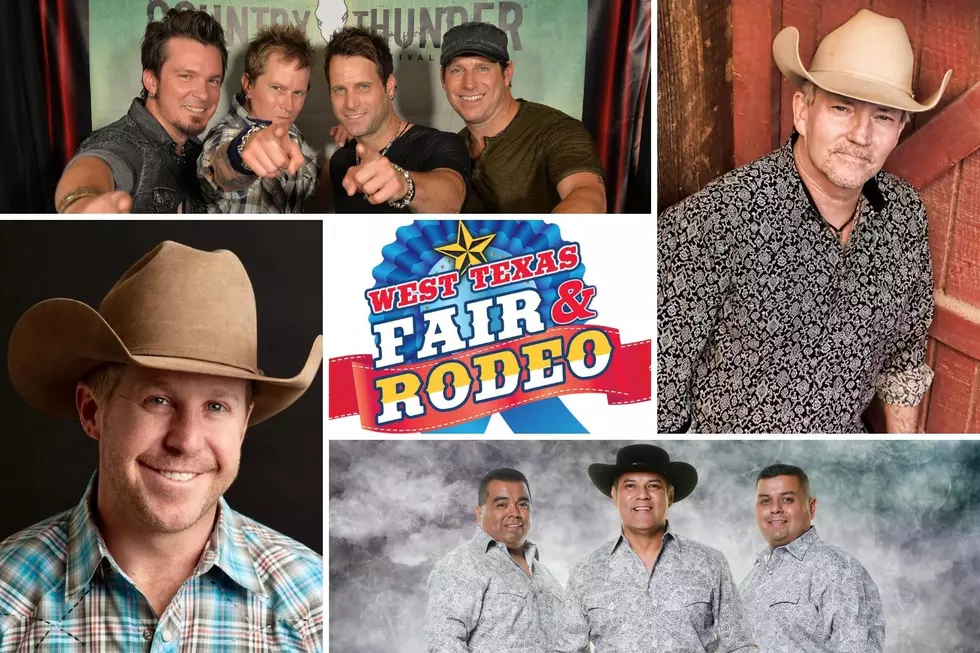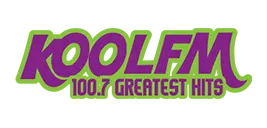
Top 50 Songs of 1984
1984 was a lot of things for music. "The '80s" as we remember them were in full swing by mid-decade. MTV arguably had its greatest influence and effect on the pop charts. And many of the decade's, if not the century's, best albums came out in 1984.
Big comebacks, creative leaps and multiplatinum records dominated the year's greatest music, as you'll see in the below list of the Top 50 Songs of 1984. As voted on by the UCR staff, these records represent a little bit of everything that went into the year's melange: rock, pop, new wave, dance, metal, punk and more.
Big artists still prevailed; David Bowie, Queen, Bruce Springsteen and Stevie Wonder - all '70s chart champs - continued to make significant records moving into their second, and sometimes third, decades while newcomers Madonna and Metallica capitalized on their debuts' success with bigger, better records. It was a busy, multifaceted year. Read on for the Top 50 Songs of 1984.
50. Talk Talk, "It's My Life"
The only single from the British new wave band to make the U.S. Top 40 served as the title track of their second album. A wildlife-centric video that got much play on MTV helped elevate the song, which includes a super-catchy chorus. Talk Talk would abandon their commercial chances by 1986 when leader Mark Hollis steered the group into more atmospheric art-rock for a trio of intricate, acclaimed albums.
49. Scandal featuring Patty Smyth, "The Warrior"
By the time Scandal made their only album (after a buzz-stirring 1982 EP), it was clear the New York City group's frontwoman, Patty Smyth, was their standout star. She received a "featuring" co-billing on The Warrior and was the main focus of the title track, the band's only Top 40 hit, co-written by in-demand songwriter Holly Knight. The band broke up following a tour, leading to a solo career for Smyth.
48. Queen, "I Want to Break Free"
Queen reached a compromise on their 11th album The Works after 1982's divisive Hot Space: Part of it would be forward-looking electronic music, and part of it would be a throwback to the band's '70s rock style. The album's second single falls somewhere in the middle. Best known for its video in which the four Queen members are dressed in drag, "I Want to Break Free" became a live staple over the next few years.
47. Bryan Adams, "Run to You"
Canadian Bryan Adams started to make some headway in the U.S. market with his third album, Cuts Like a Knife, in 1983. Reckless, which arrived a year later, took him to a whole new stratosphere. Making it to No. 1 and home to six hit singles, the LP introduced its first single, "Run to You," a month beforehand. It was his highest-charting single to date, though two other singles from the album soon topped it.
46. The Replacements, "I Will Dare"
Paul Westerberg was starting to get more comfortable with his songwriting by the time of the Replacements' third LP, Let It Be, branching out with more pop hooks and less snotty punk. The opening track "I Will Dare" featured a guitar solo by R.E.M.'s Peter Buck and a mandolin fueling the verses. It wasn't their first step toward more mature songs, but it's the one that gave them the confidence to move on.
45. Bon Jovi, "Runaway"
Bon Jovi's debut single "Runaway" was recorded once before the version that climbed into the Top 40 was made in 1982; neither included the band that would adapt the singer's surname as its moniker. A 1981 recording with studio musicians was replaced by the 1982 version, which was released in early 1984 and featured a backing group that included Canadian Aldo Nova, the E Street Band's Roy Bittan and others.
44. Stevie Wonder, "I Just Called to Say I Love You"
Stevie Wonder's hot streak hadn't cooled much in the '80s after his barnstorming '70s run of classic albums. Even a 1982 catching-up compilation yielded three new hit singles. But 1984's "I Just Called to Say I Love You," from the Wonder-composed soundtrack to the Gene Wilder comedy The Lady in Red, returned him to the No. 1 spot for the first time since 1977's "Sir Duke."
READ MORE: The Best Albums From 1983
43. Sheila E., "The Glamorous Life"
Prince had a busy year in 1984, releasing the album and film versions of Purple Rain, writing and producing the Time's Ice Cream Castle album and working on Sheila E.'s debut, The Glamorous Life. He wrote, produced and performed on the title track, a Top 10 hit. Sheila E. also appeared on "Erotic City," Prince's "Let's Go Crazy" B-side that became a club favorite during the summer's purple reign.
42. R.E.M., "So. Central Rain (I'm Sorry)"
R.E.M. didn't move too much off course from their 1983 debut Murmur's playbook; the same producer, same engineer and same studio were used during the recording of 1984's Reckoning. The LP's first single, "So. Central Rain (I'm Sorry)," was workshopped early during the Murmur touring cycle and even performed onstage nameless before it received its official title.
41. Bryan Adams, "Heaven"
"Heaven" took a long path to becoming Bryan Adams' first No. 1. The song first appeared on the soundtrack to the forgotten 1983 film A Night in Heaven before appearing on Adams' fourth album, Reckless, in November 1984. Seven months later, after its release as the LP's third single, "Heaven" made it to No. 1. It's since turned into one of Adams' most enduring songs, a concert and covered favorite.
40. Steve Perry, "Oh Sherrie"
Journey was on a short break when singer Steve Perry recorded his first solo album, Street Talk, in 1984. Its first single made its intentions clear from the start, showcasing Perry's voice, alone and cavernous, for the opening lines. "Oh Sherrie" doesn't break from Journey's radio-friendly template - Perry even performed the song onstage with the band - and holds up better than many of their era-tethered tracks.
39. Duran Duran, "The Wild Boys"
Released six months after Duran Duran's first U.S. No. 1 "The Reflex," "The Wild Boys" - a studio single included on the band's live Arena LP - peaked at No. 2 in both the U.K. and the States. Percussion-heavy, the song signaled the group's tentative move toward more experimental elements, spurred by producer Nile Rodgers, flush from success following his work on David Bowie's chart comeback Let's Dance the year before.
38. Metallica, "Fade to Black"
Metallica's 1983 debut Kill 'Em All was relentless in its thrash assault. Things lightened a little, but not much, on their follow-up album in 1984. The band later added more sophisticated arrangements and traditional rock elements to their arsenal, but on Ride the Lightning they were still primarily a thrash band. "Fade to Black," however, hinted at what was to come: a seven-minute power ballad with multiple turns along the way.
37. Leonard Cohen, "Hallelujah"
Before Jeff Buckley's overdramatic cover, before its appearance during a poignant ogre-and-donkey scene in Shrek and, Lord knows, before it became the misinterpreted go-to song for talent show contestants across the globe, "Hallelujah" was Leonard Cohen's hymn-like celebration of carnal and secular pleasures. Stick with this original, tucked away on his seventh album, Various Positions.
36. Chaka Khan, "I Feel for You"
This party on record has a stacked pedigree: Written by Prince, featuring a rap by Grandmaster Flash and the Furious Five's Melle Mel and harmonica from Stevie Wonder (not to mention a sample of his 1963 hit "Fingertips"), "I Feel for You" climbed to No. 3 during a competitive year (Prince himself blocked her path to No. 1). The track resurrected Khan's career; she occasionally performed the song onstage with its writer.
35. Depeche Mode, "People Are People"
Depeche Mode had lined up a series of hit singles in their native U.K. when "People Are People" broke them through in the U.S. The lead single from their fourth album, Some Great Reward, the song peaked inside the Top 15, setting the stage for the band's greater successes in the next decade. Although "People Are People" was a catalyst to their fortunes, the members of Depeche Mode aren't too fond of the song.
34. Twisted Sister, "We're Not Gonna Take It"
"We're Not Gonna Take It" was one of the songs named in the Parents Music Resource Center's 1985 list of "Filthy Fifteen" objectionable tracks. Twisted Sister frontman Dee Snider testified (along with John Denver and Frank Zappa) at a Senate hearing against the PMRC's proposed, and unsuccessful, labeling system. The publicity didn't boost his band's presence much: "We're Not Gonna Take It" was their only Top 40 hit.
33. R.E.M., "(Don't Go Back to) Rockville"
For the most part, R.E.M. repeated the hit formula that made them one of the most talked-about indie bands in the States following the release of their debut album, Murmur. They sharpened some of their points - the ballads got tighter, the sound fuller - and they embraced their Southern lineage on Reckoning's second single, "(Don't Go Back to) Rockville," a yee-haw country semi-joke that started as a punk song.
32. Sade, "Smooth Operator"
Sade didn't sound like too many other groups in 1984 when they released their debut album. Fronted by Nigerian-born British singer Sade Adu, the quartet combined jazz, soft rock, sophisticated pop and soul music for a distinctive style that has only grown in influence over the years. "Smooth Operator" was the third single issued from Diamond Life but the first to make the Top 40 in the U.S., where it peaked at No. 5.
31. David Bowie, "Blue Jean"
David Bowie marked a commercial comeback in 1983 with the successful Let's Dance album and a subsequent tour. He wasted no time rushing out a follow-up in Tonight the next year. While much of the album retains the same style and sound as its predecessor, Tonight also swerved in some new directions. The lead single "Blue Jean," however, was strictly in Let's Dance's blue-eyed soul mode.
30. Madonna, "Material Girl"
After Madonna's self-titled debut became a surprise hit in 1983, her record company gave a bigger push to the follow-up. Nile Rodgers, the Chic mastermind who helped stage David Bowie's recent comeback, was tapped to produce and gave the album a sonic upgrade. Like a Virgin's second single played up Madonna's publicity-baiting skills, coyly suggesting there was more to her than what her glossy image revealed.
READ MORE: 40 Albums That Turned in 2024
29. Wham! feat. George Michael, "Careless Whisper"
Not even two years passed since Wham!'s first single when George Michael started plotting his future. Following the duo's breakthrough U.S. hit "Wake Me Up Before You Go-Go" and pulled from their second album, Make It Big, the lush ballad "Careless Whisper" was released as a solo single in his native U.K. American audiences, recently introduced to the group, got a "Wham! feat. George Michael" credit instead.
28. Scorpions, "Rock You Like a Hurricane"
Scorpions had been releasing records since 1971 when they finally cracked the U.S. Top 100 in 1982 with "No One Like You"; two years later they reached the Top 40. Taken from the German band's ninth LP, Love at First Sting, "Rock You Like a Hurricane" got caught in the pop-metal surge that received a boost from MTV in the mid-'80s. They later made the Top 10 with "Winds of Change," but "Hurricane" is their creative peak.
27. Daryl Hall & John Oates, "Out of Touch"
Daryl Hall & John Oates started the '80s as one of the most popular artists on the U.S. charts. They had racked up 10 Top 10 singles, four of them No. 1s, since "Kiss on My List" topped the chart in 1981. They scored their fifth No. 1 of the '80s (and sixth overall) when the first single from their 12th album reached the top. "Out of Touch" was a bit more modern sounding than previous songs, favoring new wave dance over '70s soul.
26. Van Halen, "Jump"
The first new music from Van Halen since their lackluster Diver Down album in 1982 starts not with Eddie Van Halen's power drill guitar or even the band's earthquake rhythm section. Instead "Jump," which was released in late 1983 as a prelude to the 1984 album released in early January, greeted fans with the sound of Van Halen's new toy: an Oberheim OB-Xa synthesizer. New musical worlds awaited.
25. John Waite, "Missing You"
1984's singles chart was dominated by records that spent multiple weeks at the top spot; "Missing You" was the only one that spent a single week at No. 1. The first single from former Babys singer John Waite's second solo album, No Brakes, "Missing You" was written and added to the record at the last minute at Waite's insistence. His hunch was right: The song nestled its way to No. 1 between Tina Turner and Prince hits.
24. The Smiths, "How Soon Is Now?"
"How Soon Is Now?," one of the Smiths' best songs, was originally on the B-side of "William, It Was Really Nothing." But the nearly seven-minute Bo Diddley shuffle quickly took on a life of its own, eventually reaching the U.K. Top 25 and platinum status. The distinctive tremolo guitar added a new layer to the band's evolving stylebook, which continued to expand over the next couple of years.
23. Dio, "The Last in Line"
Ronnie James Dio was one of the biggest names in metal, thanks to his earlier gigs in Rainbow and Black Sabbath, where he replaced the booted Ozzy Osbourne, and the debut album by his self-named band, a beloved work in the blossoming genre. The title track of their second album was supported by a bonkers video featuring an underground-dwelling cyborg and Dio as a hero resistance fighter. The '80s!
22. Pretenders, "Middle of the Road"
Chrissie Hynde was still shaken by the deaths of two of her Pretenders bandmates when the band's third album was released in January 1984. Preceded by "Middle of the Road," Learning to Crawl took steps toward making sense of the tragedy. In addition to songs about her daughter, her late bandmates and her birthplace, the LP-opening "Middle of the Road" reflected on aging: "I'm not the cat I used to be, I got a kid, I'm 33."
21. Tears for Fears, "Shout"
Released in November 1984 as the second single from their upcoming album, Songs From the Big Chair (which came out in February 1985), Tears for Fears pushed against the perception that pop singles avoided deep and dark subjects. Combining themes of primal therapy (a big part of the album) and social protest, "Shout" became the group's second U.S. No. 1 following "Everybody Wants to Rule the World."
20. Bruce Springsteen, "Dancing in the Dark"
Born in the U.S.A. was a meld of several things Springsteen had brewing in the first part of the '80s: leftover Nebraska tracks, a tentative and abandoned LP called Murder Incorporated and new songs worked out with the E Street Band in mind. What it wasn't, however, was a pop record, until manager Jon Landau told the Boss he needed a hit single. So he wrote "Dancing in the Dark," which made it to an all-time-highest No. 2.
19. Cyndi Lauper, "Girls Just Want to Have Fun"
Cyndi Lauper's group Blue Angel bottomed out after one album; her solo debut, She's So Unusual, didn't suffer the same fate. Stacked with five hit singles, the LP wasted no time setting up Lauper's quirky image with its first single, a cover of Robert Hazard's 1979 song "Girls Just Want to Have Fun." By early 1984 the track was all over radio and MTV, peaking at No. 2. There was more to come.
18. Ratt, "Round and Round"
Few bands benefited more from MTV's embrace of the burgeoning glam-metal genre than Los Angeles' Ratt. Armed with tight spandex, teased hair and a mile-high pop hook, "Round and Round" (and its video) sent the band to the Top 20 for the only time in their career. The parent album, Out of the Cellar, Ratt's debut, made it to No. 7.
17. Iron Maiden, "2 Minutes to Midnight"
At more than six minutes, "2 Minutes to Midnight" ran longer than the typical single, but Iron Maiden's doom-and-gloom opus based on the Doomsday Clock that charts mankind's nearness to total apocalypse is not a typical single. The clock was set at three minutes to midnight at the time of the song's release, the closest it's been to global annihilation since 1953 when it was at two minutes.
16. Cyndi Lauper, "Time After Time"
Cyndi Lauper wrote only four songs on her multiplatinum solo debut, and half of those are throwaways. But "Time After Time" - a co-write with the Hooters' Rob Hyman and the second single pulled from She's So Unusual - was an instant classic, a timeless ballad that became Lauper's first No. 1. A bigger honor arrived the next year, when jazz great Miles Davis covered "Time After Time" and made it a regular in his live sets.
15. Sammy Hagar, "I Can't Drive 55"
Not long before Sammy Hagar began work on his eighth solo album, he got a speeding ticket for going seven miles over the mandated 55 mph limit. One of his most popular songs was soon born. The track helped send VOA to platinum sales and place Hagar at the front of the line when Van Halen started looking for a new singer in 1985 to replace the departing David Lee Roth.
14. Metallica, "For Whom the Bell Tolls"
Rock music has its share of chin-rubbing literary references, from Bob Dylan's vast carnival of allusions to Led Zeppelin's mountain-hopping Hobbit nods. In "For Whom the Bell Tolls," Metallica borrows a title and theme from Ernest Hemingway's 1940 novel about the Spanish Civil War. Cliff Burton's disorienting bass intro reflects the inevitability of death as chaos spirals around the bloody musical landscape.
13. U2, "Pride (In the Name of Love)"
A near-rigid conceptual plan knotted U2's first three albums - a trilogy exploring single themes laid out by their one-word LP titles. For their fourth album, the Irish band hired new producers (sound architects Brian Eno and Daniel Lanois) and worked outside their comfort zone, diving into the myths and heart of America. The Unforgettable Fire's lead single, "Pride (In the Name of Love)," paid tribute to Martin Luther King.
12. Van Halen, "Hot for Teacher"
Eddie Van Halen's experiments with Oberheim synthesizers dominated much of the talk surrounding his band's sixth album. But 1984's forward-looking set pieces often nuzzled against the muscular hard rock Van Halen had honed in the years leading up to the LP. The fourth and final single from the album was fueled by pure adrenaline and a room-shaking, half-minute drum solo that starts the whole thing.
READ MORE: Top 30 Songs of 1983
11. Foreigner, "I Want to Know What Love Is"
"Waiting for a Girl Like You" proved there was an audience for big power ballads from a hard-rock band like Foreigner. So they went even bigger on the first single from their 1984 album Agent Provocateur. Enlisting the New Jersey Mass Choir, Dreamgirls star Jennifer Holliday and Thompson Twins' Tom Bailey, "I Want to Know What Love Is" went to No. 1. The platinum-selling hit remains the band's most popular song.
10. Tina Turner, "What's Love Got to Do With It"
Tina Turner launched her brilliant second act with this song, setting the stage for her comeback album Private Dancer. After breaking free from her abusive husband Ike, the singer's solo career stumbled until a cover of Al Green's "Let's Stay Together" returned her to the charts at the top of 1984. By the middle of the year, "What's Love Got to Do With It" was No. 1 and on its way to snagging a Grammy for Record of the Year.
9. Madonna, "Like a Virgin"
Madonna took more control of her career on her second album, having a say in her choice of producer and songs. She was still some distance away from her total artistic independence, but Like a Virgin marked the start of her move. The title track, and the album's first single, played up the winking sensuality Madonna was bringing to her videos and live performances. She'd push further going forward; this was the start.
8. Bruce Springsteen, "Born in the U.S.A."
Misinterpreted as a patriotic anthem and the centerpiece of the album that made Bruce Springsteen one of the biggest artists on the planet, "Born in the U.S.A." has lost little of its force over the years. Relating the story of a returning Vietnam vet neglected by the country he served, the song - the third of seven straight Top 10 singles from the LP - achieved the near impossible: bringing critical '80s political discourse to the pop charts.
7. Van Halen, "Panama"
If the first two singles from Van Halen's career-shifting 1984 album left original fans scratching their heads over the synth-led sounds found on several tracks, the third song pulled for airplay was more to their liking. "Panama" kept it pretty simple: a handful of guitar chords played with little fuss or modern obstacles. Like its synth-driven predecessor, "I'll Wait," "Panama" - about a car, not the country - stopped at No. 13.
6. Bryan Adams, "Summer of '69"
Bryan Adams' fourth album was released in November 1984. Good thing - the late arrival during a year dominated by Michael Jackson, Prince and Bruce Springsteen allowed Reckless to slowly work its way to No. 1 (which it did nine months later, in August 1985). Released as the album's fourth single, the arena-ready "Summer of '69" climbed into the Top 5, fittingly, in the summer of '85.
5. The Cars, "Drive"
One of the keys to the Cars' popularity in the late '70s and early '80s was the hot-and-cold dynamic between Ric Ocasek's icy new wave-inspired vocals and Benjamin Orr's more soulful offerings. The bassist's rich, warm voice was the perfect complement to the Ocasek-penned ballad "Drive" and the cascading blankets of synthesizers that underline the song. Peaking at No. 3, it became the band's biggest hit.
4. Prince and the Revolution, "Let's Go Crazy"
The first song on Prince's summer-dominating Purple Rain soundtrack was designed as an album opener. From its sermon-like "Dearly beloved, we are gathered here today to get through this thing called life" to the chorus' declaration of "Let's get nuts," "Let's Go Crazy" was an invitation to Prince's anything-goes universe of sex, doves and Hendrix worship. It followed the path-clearing "When Doves Cry" to No. 1.
3. Prince and the Revolution, "Purple Rain"
The closing title song on Prince's masterpiece Purple Rain, clocking in at nearly nine minutes on the album, was recorded live in his hometown of Minneapolis in August 1983. It served as the epic finale of both the movie and record, evoking a Jimi Hendrix-style guitar solo amid its lighter-waving balladic sweep. An edited version of "Purple Rain" made it to No. 2 at the end of Prince's princely year.
2. Prince, "When Doves Cry"
Purple Rain was the first Prince album to give co-credit to his band the Revolution, but the record's first single, "When Doves Cry," was strictly a solo track credited to only Prince (just like all of his preceding singles). The song came out a little more than a month before Purple Rain's release in mid-June and became his first No. 1. By the end of the year he was never bigger, dominating with a hit album, singles and movie.
1. Don Henley "The Boys of Summer"
Don Henley's social consciousness sprouted on Eagles' Hotel California closing "The Last Resort." By the time of his second solo album, he grew more reflective, too, shying away from his band's tales of excess and Hollywood debauchery. Building the Perfect Beast's centerpiece, "The Boys of Summer," was wistful in the eye of the storm, with Henley bemoaning Grateful Dead stickers representing '80s American greed and the inevitable passing of time, a theme he'd explore even deeper on 1989's The End of the Innocence.
Top 50 Albums of 1984
Gallery Credit: Michael Gallucci
More From 100.7 KOOL FM










